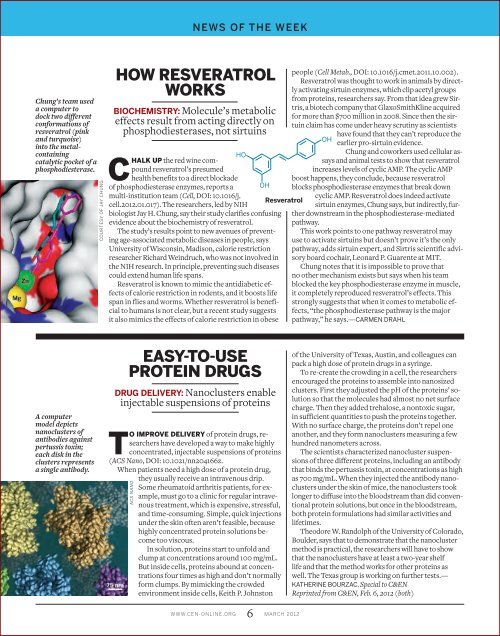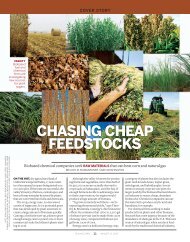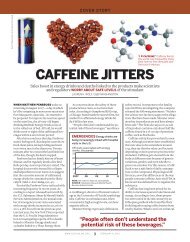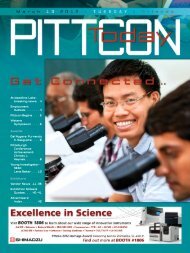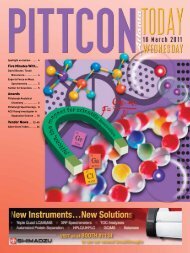focus on life sciences - Chemical & Engineering News - American ...
focus on life sciences - Chemical & Engineering News - American ...
focus on life sciences - Chemical & Engineering News - American ...
- No tags were found...
Create successful ePaper yourself
Turn your PDF publications into a flip-book with our unique Google optimized e-Paper software.
NEWS OF THE WEEKChung’s team useda computer todock two differentc<strong>on</strong>formati<strong>on</strong>s ofresveratrol (pinkand turquoise)into the metalc<strong>on</strong>tainingcatalytic pocket of aphosphodiesterase.COURTESY OF JAY CHUNGHOW RESVERATROLWORKSBIOCHEMISTRY: Molecule’s metaboliceffects result from acting directly <strong>on</strong>phosphodiesterases, not sirtuinsHOCHALK UP the red wine compoundresveratrol’s presumedhealth benefits to a direct blockadeof phosphodiesterase enzymes, reports a OHmulti-instituti<strong>on</strong> team ( Cell, DOI: 10.1016/j.cell.2012.01.017). The researchers, led by NIHbiologist Jay H. Chung , say their study clarifies c<strong>on</strong>fusingevidence about the biochemistry of resveratrol.The study’s results point to new avenues of preventingage-associated metabolic diseases in people, saysUniversity of Wisc<strong>on</strong>sin, Madis<strong>on</strong>, calorie restricti<strong>on</strong>researcher Richard Weindruch , who was not involved inthe NIH research. In principle, preventing such diseasescould extend human <strong>life</strong> spans.Resveratrol is known to mimic the antidiabetic effectsof calorie restricti<strong>on</strong> in rodents, and it boosts <strong>life</strong>span in flies and worms. Whether resveratrol is beneficialto humans is not clear, but a recent study suggestsit also mimics the effects of calorie restricti<strong>on</strong> in obeseResveratrolpeople ( Cell Metab., DOI: 10.1016/j.cmet.2011.10.002 ).Resveratrol was thought to work in animals by directlyactivating sirtuin enzymes, which clip acetyl groupsfrom proteins, researchers say. From that idea grew Sirtris,a biotech company that GlaxoSmithKline acquiredfor more than $700 milli<strong>on</strong> in 2008. Since then the sirtuinclaim has come under heavy scrutiny as scientistsOHhave found that they can’t reproduce theearlier pro-sirtuin evidence.Chung and coworkers used cellular assaysand animal tests to show that resveratrolincreases levels of cyclic AMP. The cyclic AMPboost happens, they c<strong>on</strong>clude, because resveratrolblocks phosphodiesterase enzymes that break downcyclic AMP. Resveratrol does indeed activatesirtuin enzymes, Chung says, but indirectly, furtherdownstream in the phosphodiesterase-mediatedpathway.This work points to <strong>on</strong>e pathway resveratrol mayuse to activate sirtuins but doesn’t prove it’s the <strong>on</strong>lypathway, adds sirtuin expert, and Sirtris scientific advisoryboard cochair, Le<strong>on</strong>ard P. Guarente at MIT.Chung notes that it is impossible to prove thatno other mechanism exists but says when his teamblocked the key phosphodiesterase enzyme in muscle,it completely reproduced resveratrol’s effects. Thisstr<strong>on</strong>gly suggests that when it comes to metabolic effects,“the phosphodiesterase pathway is the majorpathway,” he says. — CARMEN DRAHLA computermodel depictsnanoclusters ofantibodies againstpertussis toxin;each disk in theclusters representsa single antibody.EASY-TO-USEPROTEIN DRUGSDRUG DELIVERY: Nanoclusters enableinjectable suspensi<strong>on</strong>s of proteinsTO IMPROVE DELIVERY of protein drugs, researchershave developed a way to make highlyc<strong>on</strong>centrated, injectable suspensi<strong>on</strong>s of proteins( ACS Nano , DOI: 10.1021/nn204166z .When patients need a high dose of a protein drug,they usually receive an intravenous drip.Some rheumatoid arthritis patients, for example,must go to a clinic for regular intravenoustreatment, which is expensive, stressful,and time-c<strong>on</strong>suming. Simple, quick injecti<strong>on</strong>sunder the skin often aren’t feasible, becausehighly c<strong>on</strong>centrated protein soluti<strong>on</strong>s becometoo viscous.In soluti<strong>on</strong>, proteins start to unfold andclump at c<strong>on</strong>centrati<strong>on</strong>s around 100 mg/mL.But inside cells, proteins abound at c<strong>on</strong>centrati<strong>on</strong>sfour times as high and d<strong>on</strong>’t normallyform clumps. By mimicking the crowdedenvir<strong>on</strong>ment inside cells, Keith P. Johnst<strong>on</strong>ACS NANOof the University of Texas, Austin , and colleagues canpack a high dose of protein drugs in a syringe.To re-create the crowding in a cell, the researchersencouraged the proteins to assemble into nanosizedclusters. First they adjusted the pH of the proteins’ soluti<strong>on</strong>so that the molecules had almost no net surfacecharge. Then they added trehalose, a n<strong>on</strong>toxic sugar,in sufficient quantities to push the proteins together.With no surface charge, the proteins d<strong>on</strong>’t repel <strong>on</strong>eanother, and they form nanoclusters measuring a fewhundred nanometers across.The scientists characterized nanocluster suspensi<strong>on</strong>sof three different proteins, including an antibodythat binds the pertussis toxin, at c<strong>on</strong>centrati<strong>on</strong>s as highas 700 mg/mL. When they injected the antibody nanoclustersunder the skin of mice, the nanoclusters tookl<strong>on</strong>ger to diffuse into the bloodstream than did c<strong>on</strong>venti<strong>on</strong>alprotein soluti<strong>on</strong>s, but <strong>on</strong>ce in the bloodstream,both protein formulati<strong>on</strong>s had similar activities and<strong>life</strong>times.Theodore W. Randolph of the University of Colorado,Boulder , says that to dem<strong>on</strong>strate that the nanoclustermethod is practical, the researchers will have to showthat the nanoclusters have at least a two-year shelf<strong>life</strong> and that the method works for other proteins aswell. The Texas group is working <strong>on</strong> further tests. —KATHERINE BOURZAC , Special to C&ENReprinted from C&EN, Feb. 6, 2012 (both)WWW.CEN-ONLINE.ORG 6 MARCH 2012


